#Animal reservoir species
Text
The Best News of Last Week - June 26, 2023
1. California's Lake Oroville now at 100% capacity following megadrought; 1st time since 2019

Once a stark example of the drastic effects of California's yearslong megadrought, Lake Oroville has rebounded and is once again filled to capacity, data from the state's Department of Water Resources shows.
Lake Oroville, the state's most beleaguered and second-largest reservoir, is at 100% of its total capacity and 127% of where it should be around this time of year - a huge boost after the climate-change-fueled megadrought sucked away nearly all its water supply.
2. Blue whales are thriving in California waters – the story of their amazing comeback
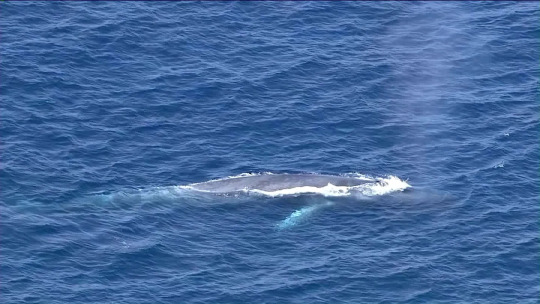
If you’ve recently taken a Southern California whale-watching tour, you may have been lucky enough to come across earth’s largest animal. Pacific blue whales grow up to 110 feet long and can reach a weight of 200 tons. Decades ago, blue whales were nearly hunted to extinction, and although still listed as protected under the Endangered Species Act, marine biologists and researchers are heralding a “conservation success story,” unlike any other.
According to a study published in 2014 by researchers at the University of Washington, the West Coast blue whale population has bounced back at tremendous levels, recouping 97% of its pre-whaling population
3. Newborn left in Florida Safe Haven Baby Box adopted by the firefighter who found her

Zoey is now 5 months old. Courtesy Zoey's family
A firefighter in Ocala, Florida, was pulling an overnight shift at the station in January when he was awakened at 2 a.m. by an alarm. He recognized the sound immediately. A newborn had been placed in the building’s Safe Haven Baby Box, a device that allows someone to safely and anonymously surrender a child — no questions asked.
“To be honest, I thought it was a false alarm,” said the firefighter, who wished to remain anonymous to protect his family’s privacy. But when he opened the box, he discovered a healthy infant wrapped in a pink blanket.
That baby would become his daughter, Zoey.
4. Iceland suspends whale hunt on animal welfare concerns
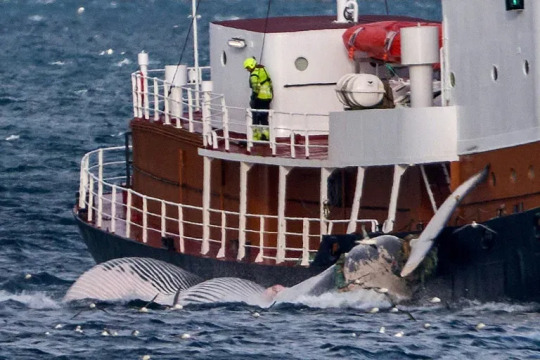
Iceland's government said Tuesday it was suspending this year's whale hunt until the end of August due to animal welfare concerns, likely bringing the controversial practice to a historic end.
"I have taken the decision to suspend whaling" until August 31, Food Minister Svandis Svavarsdottir said in a statement. The country's last remaining whaling company, Hvalur, had previously said this would be its final season as the hunt has become less profitable.
5. He wanted to pet dogs for his 100th birthday. Hundreds lined up.

Alison Moore had a unique idea to celebrate her father's 100th birthday: a pet parade filled with as many dogs as possible. Her father, Robert Moore, has always adored dogs and wanted to pet every one he saw. So, Alison took to social media and invited the community to join in the festivities. Little did she know that over 200 dogs and their owners would gather for the heartwarming event.
The parade brought immense joy not only to Robert but also to attendees like Rodger, who has Alzheimer's disease, and his daughter Denise, who hadn't seen her father smile so much in a long time. It was a day filled with wagging tails, smiling faces, and love that made Robert's milestone birthday an unforgettable celebration.
6. Historic decision: Estonia legalizes same-sex marriage

Tuesday, the Estonian government has survived a vote of no confidence in the Riigikogu tied to amendments to the Family Law Act and related legislation, which is granting same-sex couples the legal right to wed. 55 members of the Riigikogu voted in favor of the measure, while 34 voted against.
It is proposed that the institution of marriage, as defined by family law, be modified so that any two natural persons of legal age, regardless of gender, may marry. The words "man and woman" will be replaced with the words "two natural persons."
7. US approves chicken made from cultivated cells, the nation's first 'lab-grown' meat

For the first time, U.S. regulators on Wednesday approved the sale of chicken made from animal cells, allowing two California companies to offer “lab-grown” meat to the nation’s restaurant tables and eventually, supermarket shelves.
The Agriculture Department gave the green light to Upside Foods and Good Meat, firms that had been racing to be the first in the U.S. to sell meat that doesn’t come from slaughtered animals — what’s now being referred to as “cell-cultivated” or “cultured” meat as it emerges from the laboratory and arrives on dinner plates.
----
That's it for this week :)
This newsletter will always be free. If you liked this post you can support me with a small kofi donation:
Support this newsletter ❤️
Also don’t forget to reblog.
1K notes
·
View notes
Text
This is a really exciting development! We've already seen the positive effects of beavers returning to their historic range here in North America, so it's even better to see the same thing underway across the Atlantic. A single pair with their first litter of kits certainly isn't a large-scale reintroduction, but it's proof that these animals have the capacity to get back to work here.
Beavers are often called ecosystem engineers, and for good reason. These keystone species alter waterways by building dams and lodges, creating ponds and other aquatic habitats for species that can't handle faster-moving water. These also often serve as water reservoirs during summer droughts. The dams and lodges themselves may also provide nesting sites for birds and shelter for other animals, plants, and fungi.
Sadly there are still people who want to see beavers trapped and hunted as pests because their dams can sometimes flood fields, to include those that were historically seasonal wetlands. Until we stop seeing animals' value only in terms of whether they're useful to us or not, the beavers are going to face opposition as they reclaim their old territories on both continents.
Nonetheless, I give a hearty cheer to the Mammalian Corps of Engineers!
#beavers#beaver#mammals#rodent#wildlife#animals#ecosystems#ecology#restoration ecology#nature#environment#conservation#science#scicomm#hopepunk#endangered species#extinction#biodiversity#wild animals#good news
987 notes
·
View notes
Text
Protean, Renegwe
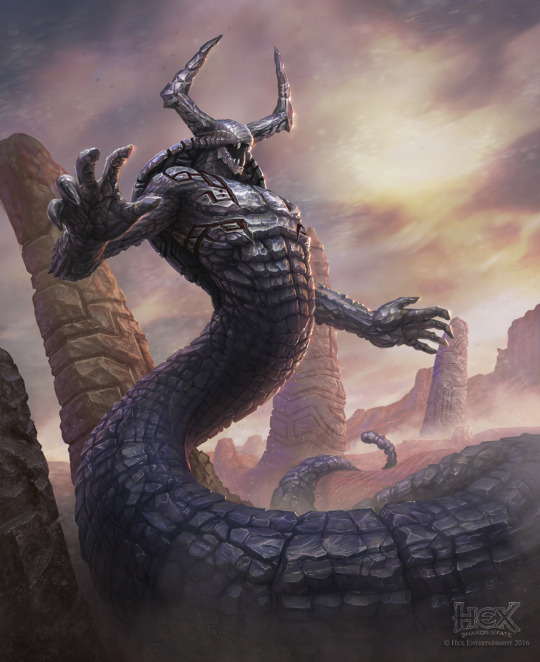
"Fang of Nulzann" © Hex Entertainment, by Martin de Diego. Accessed at his deviantArt here
[My final original species of protean, this time embodying plate tectonics as a manifestation of change. I knew I wanted to do a continental drift-themed protean, and this was one of the first art pieces I found when embarking on this project. As a reminder, all of my protean species have a name that's an anagram. I'll be posting the solutions to those at the end of the week.]
Protean, Renegwe
CR 19 CN Outsider (extraplanar)
This massive creature appears like a snake with a humanoid torso, its body composed of black volcanic rock. A snort hood grows between its head and neck, and a pair of horns like bent stalagmites grows from its head. It shimmers with heat.
A renegwe is a protean devoted to some of the most dramatic changes in the cosmos—plate tectonics. Renegwes are the shepherds of whole continents, observing them move over the course of thousands or millions of years, and steering them if their whims dictate they speed up or slow down. Rather than the immediate thrills of transforming a person into an animal, or the destruction of killing enemies and overthrowing governments, renegwes prefer the gradual pleasures of growing mountains, eroding canyons and rock formation. That is not to say that they cannot be dramatic—a renegwe who grows bored with a landmass’ progress might start earthquakes with magic, or heat up a lava reservoir to re-activate a dormant volcano.
Few renegwes care much about the short lives of humanoids directly, but may become territorial of particular mineral deposits and protect them from mining or other exploitation. They might also come into conflict with magical creatures that seek to stop or mitigate the destruction their earthquakes and volcanoes engender. A renegwe prefers to fight atop or within a solid surface—although they can fly, they feel much more comfortable when touching earth or stone. Renegwes spew lava from their mouths and can fire exploding boulders from their hands. They have relatively few spell-like abilities compared to other proteans, and prefer simple melee tactics to pitched battles at a distance.
Renegwes are more common outside the Maelstrom than in it. They dwell mostly deep underground on planets of the Material Planes, or in places where the Planes of Earth and Fire overlap. From these magma-rich bastions, they may plot against the shaitans and efreeti—both of these genies types are lawful, and seek to impose order where the renegwes prefer chaos. Renegwes are natural allies of magma dragons, but these allegiances may be fractious and marked by power struggles. Few renegwes have much interest in the politics of the protean choirs, but may work for a given protean lord on a temporary basis when their interests overlap. The protean lord most sympathetic to the renegwes is Etna, herself a being of volcanic power.
Renegwe CR 19
XP 204,800
CN Gargantuan outsider (chaotic, earth, extraplanar, fire, protean)
Init +6; Senses blindsight 60 ft., darkvision 60 ft., Perception +31, tremorsense 120 ft.
Aura cloak of chaos (DC 26)
Defense
AC 34, touch 12, flat-footed 32 (-4 size, +2 Dex, +4 deflection, +22 natural)
hp 330 (20d10+220)
Fort +23, Ref +20, Will +26
DR 15/adamantine and lawful; Immune acid, fire; Resist electricity 10, sonic 10; SR 30
Defensive Abilities amorphous anatomy, fiery body, freedom of movement, rock catching
Offense
Speed 40 ft., burrow 80 ft. (earth glide), fly 80 ft. (good)
Melee bite +31 (2d8+15 plus 2d6 fire), gore +31 (2d8+15 plus 2d6 fire), 2 claws +31 (2d6+15/19-20 plus 2d6 fire), tail slap +29 (2d8+7 plus 2d6 fire plus grab)
Ranged 2 lava bombs +18 touch (4d6 bludgeoning plus 2d6 fire)
Space 20 ft.; Reach 20 ft.
Special Attacks breath weapon (80 ft. cone, 20d6 fire, Ref DC 31), earth mastery, trample (2d8+22 plus 2d6 fire, DC 35)
Spell-like Abilities CL 19th, concentration +27
Constant—cloak of chaos (self only, DC 26)
At will—chaos hammer (DC 22), scorching ray, stone shape
3/day—earthquake, empowered flame strike (DC 23), greater dispel magic, quickened wall of stone, word of chaos (DC 25)
1/day—clashing rocks (DC 27), repel metal or stone, wall of lava (DC 26)
Statistics
Str 41, Dex 15, Con 32, Int 14, Wis27, Cha 26
Base Atk +20; CMB +39 (+41 bull rush, +43 grapple); CMD 55 (57 vs. bull rush, cannot be tripped)
Feats Awesome Blow, Combat Reflexes, Empowered SLA (flame strike), Flyby Attack, Improved Bull Rush, Improved Critical (claw), Improved Initiative, Multiattack, Power Attack, Quicken SLA (wall of stone)
Skills Bluff +29, Disguise +26, Fly +25, Intimidate +29, Knowledge (geography, planes) +23, Perception +31, Sense Motive +29, Survival +29
Languages Abyssal, Draconic, Ignan, Protean, Terran, telepathy 100 ft.
SQ change shape (dragon or elemental, elemental shape IV or form of the dragon III), no breath
Ecology
Environment underground (Maelstrom)
Organization solitary, pair or geoform (3-6)
Treasure standard
Special Abilities
Breath Weapon (Su) Any creature that takes damage from a renegwe’s breath weapon is coated in lava, taking 10d6 points of fire damage for the next 1d3 rounds (no save).
Change Shape (Su) A renegwe can change shape at will, but does not gain the healing from changing shape as is typical for proteans. It can only assume the form of dragons or elementals with the earth or fire subtypes.
Earth Mastery (Ex) When both a renegwe and its opponent are touching the ground, the renegwe gains a +1 bonus on attack and damage rolls.
Fiery Body (Ex) A renegwe’s body is blazing hot. It deals 2d6 points of fire damage with all of its natural attacks, and any creature striking it with a melee touch attack, natural weapon or unarmed strike takes 2d6 points of fire damage.
Lava Bombs (Su) As a standard action, a renegwe can fire two lava bombs, one from each hand. Each lava bomb is treated as a ranged touch attack with a range of 200 feet and no range incremenent. A creature struck takes 4d6 points of bludgeoning damage and 2d6 fire, and then the lava bomb explodes, dealing 10d6 points of fire damage in a 40 foot radius (Reflex DC 29 half). If a creature is in the radius of both lava bombs, it makes a single save at a -4 penalty, and treats the fire damage as coming from a single source. A renegwe can use its lava bombs once every 1d4 rounds. The save DC is Charisma based.
63 notes
·
View notes
Text
Kakhovka reservoir.
Before and after the dam explosion.
The scale of the disaster caused by the russian occupiers at the this moment👇
20 settlements are flooded on the right bank of the Dnieper (as of 11:30 on June 7);
17 settlements can be resettled (16 thousand inhabitants);
Under the threat of destruction - 333 species of animals and plants, ecosystems of the national parks Nizhnedneprovsky, Veliky Lug, Kamenskaya Sich, Beloberezhye Svyatoslav 10 thousand hectares of agricultural land will be flooded;
31 field irrigation systems will be stopped in Dnepropetrovsk (30%), Kherson (94%) and Zaporozhye (74%) regions; the fishing industry is expected to lose 95 thousand tons of adult fish;
At least 150 tons of engine oil have already entered the Dnieper River.
#russian terrorism#russia is the occupier#russia is a terrorist state#russia terrorist state#nova kahovka#nova kakhovka dam#kakhovka hydroelectric power plant#kakhovska dam#kakhovka hpp#ukraine#standwithukraine#stand with ukraine
127 notes
·
View notes
Text
The 11 most venomous animals you can find in Germany
Ususlly you would think about exotic species when it comes to venomous animals, particularly species from Australia. Others are so common that they spontaneously don't come to our mind, such as bees, wasps, or hornets.
However, there are indeed venomous species that live in Germany, which can cause discomfort to severe pain, and – in rare cases – death.

Ammen-Dornfinger (Yellow Sac Spider), its fangs can penetrate the human skin and inject poison into the tissue. Symptoms are usually not worse than a bee sting, but can also cause nausea, vomiting, and shivers.
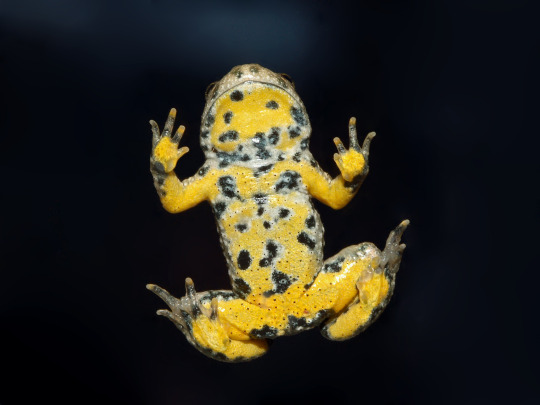
Gelbbauchunke (Yellow-Bellied Toad), the mucus contains a poison that is irritating to the skin and particulaly the mucosa and the eyes.
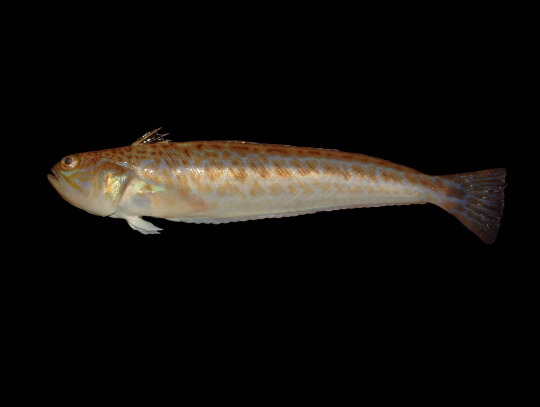
Petermännchen (Weeverfish), likes to bury itself in the ground near sandy beaches so that only the venomous spines stick out, causing a danger to the feet of tourusts. The symptoms include excruciating pain, swelling, redness, heat, neusea, vomiting, joint aches, headache, lightheadedness, increased urination, tremors, and in rare cases abnormal heart rhythm, seizures, gangrene, tissue degeneration, and unconciousness. This fish is considered the most dangerous venomous species that lives in Germany.

Spitzmäuse (Shrews) have venomous teeth. However, they rarely bite humans, and even more rarely have the power topenetrate the skin. They mostly use their venom to kill insects.

Kreuzotter (Common European Viper) are elusive animals, so very few peple have actually seen one. Their venom is three times more poisonous than that of the most dangerous rattlesnake. However, the viper doesn't like to waste its venom, that it also uses for hunting, for defense, and it has a much smaller reservoir. That's why the viper is only dangerous for small children and elderly people. Between 1959 and 2003, no viper-related deaths were recorded, and in 2004, an 81-year-old woman died. Victims often have to be hospitalized, about 10 % of them required ICU treatment. The symptoms include severe swelling, shortness of breath, and heart issues, in rere cases paralysis of the affected limb. On the other hand, numerous cases are known where the victims had no symptoms at all, probably because the viper didn't inject the venom.
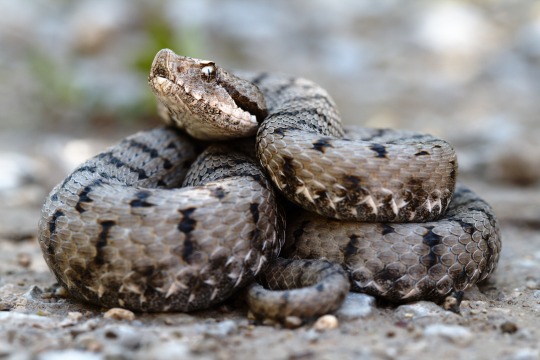
Aspisviper (Aspic Viper) occurs only in the southern parts of the Black Forest and is very rare. The venom is similar to that of the common viper. It is expected to expand its territory in the future due to global warming.
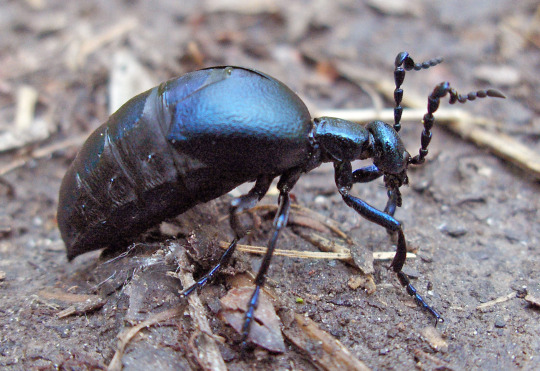
Schwarzblauer Ölkäfer (European Oil Beetle) sprays a substance that is severely irritant to eyes and mucosa.

Eichen-Prozessionsspinner (Oak Processionary), hairs of the larvae easily break off and float through the air. They contain a venom that causes symptoms that reach from mild urticaria to severe dermatitis. If inhaled, the hairs can cause bronchitis, painful cough, and asthma.
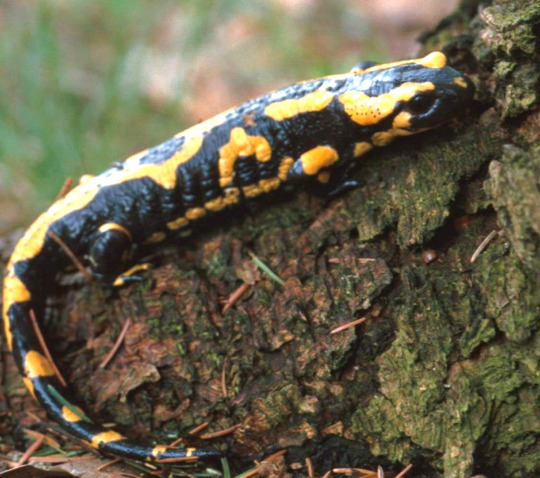
Feuersalamander (Fire Salamander) has venom on the surface of the skin. In humans, it causes a slightly burning sensation on the skin, but it is absolutely deadly for dogs.

Gelbe Haarqualle / Feuerqualle (Lion's Mane Jellyfish): Touching this jellyfish causes excruciating pain, eczema, fever and breathing trouble.

Wasserspinne (Diving Bell Spider) can penetrate the human skin and inject venom. The effects are usually mild and not worse than a bee sting.
315 notes
·
View notes
Text
A writer’s guide to forests: from the poles to the tropics, part 7
Is it no.7 already? Wow. A big shout out to everyone who has had the patients to stick with this. Now onto this week’s forest…
Dry forest
Water is life. That’s a fact. And especially where it doesn’t rain for more than half the year.
Location: Dry forests are scattered throughout the Yucatán peninsula ,South America, various Pacific islands,Australia, Madagascar, and India. Areas have been cleared by human activity, and the SA dry forests are classified as the most threatened tropical forests.
Climate: Temperate to tropical, with just enough rain to sustain trees. Many are monsoonal, with rain coming in one or two brief periods separated by a long dry season.
Plant life- Hardy trees, such as Baobab and Eucalyptus are able to last with little rain by tapping into groundwater with extensive root systems. Many trees are evergreen, but in India, many species are deciduous. Trees are often more spaced out, and shrubs and grasses grow extensively. Cacti are common plants in the Americas, with some growing tall enough to be considered trees. In order to survive the heat and lack of water, many small plants are annuals, or store water in tubers. Palms can make up a large percentage of the trees, as was the case in the now vanished forests of Easter Island.
Animal life- As they can come and go when they please, birds are common species. Larger animals are active year round, with smaller species of mammals, amphibians, and certain insects only coming out during the rainy season. Isolation means that islands become home to many endemic species; think about Madagascar and the lemurs, or Darwin’s finches, iguanas, and tortoises in the Galapagos. Isolation has also led to the marsupials of Australia developing to fill the niches that would normally be occupied by placental mammals .The introduction of invasive species has brought about the extinction of island fauna.
How the forest affects the story- Water, or the lack of will be the biggest challenge your characters will face. Rivers and lakes may be seasonal, so other sources will have to be utilized. Drinkable fluids can be obtained from various plants and animals, or maybe the bedrock is porous and water accumulates in cenotes. Your characters could come from a culture that builds artificial reservoirs to collect the rain and store it for the dry season. With careful water management, cities can thrive in dry areas. But your characters will have to be careful. Prolonged drought will see societies go the way of the Maya. Deforestation leaves the topsoil vulnerable to the wind, and forests, farms, and grassland will inevitably turn to desert. Whether nomadic or sedentary, your characters and their society will have to find a way to interact with the forest without destroying it or themselves. Can they do it? Can a damaged biosphere be restored before it’s too late? The success or failure of your characters and/or their predecessors can be a driving focus of the plot. Of course ,when the rains do come, it could be in the form of a cyclone. Dry ground does not readily absorb water, and flash floods are a danger. Water can grant life, but it can take it as well.
#writing#creative writing#writing guide#writing inspiration#writing prompts#writer#writers#writing community#writer on tumblr#writeblr
47 notes
·
View notes
Note
So you see, Fennel.. [get ready to read this all creator😭😭]
All domestic cats belong to a single species – Felis catus. This is in spite of the great variety of modern cat breeds, from the sleek blue-eyed Siamese and beautifully-spotted Ocicat, to the snub-nosed Persian and the tiny Munchkin. They all belong to the Felidae branch of the animal family tree.
The Felidae is made up of two subfamilies – the Felinae, which includes domestic cats, all the smaller wild cats, and some medium sized beasts such as the Puma, Bobcat, Serval and Cheetah. The other branch of the family, the Pantherinae, contains the big scary ones. We’re talking about Lions, Tigers, Leopards, and Jaguars.
The domestic cat’s wild ancestor is the African Wild Cat, also known as the Near Eastern Cat, (Felis silvestris lybica) – not its very close relative the European Wild Cat (Felis silvestris silvestris). This isn’t just guesswork – the evidence is all there in the cat’s DNA (the genetic coding that makes each species, and each individual within a species, unique). Domestic cats split off from their ancestor around 10,000 years ago. That’s a long history for a family pet!
And in case you start thinking your pet puss is a million miles away from all those lions, tigers and leopards, you may be shocked to hear that kitty shares 95% of her DNA with an African Lion. Not quite as close as humans and Chimpanzees (98.8%), but still very close cousins.
And, when you think about it, cats are just a small pounce away from their wild state, no matter how much they cuddle up and purr in your lap. Hunting and self-sufficiency are second nature to them, as the millions of feral cats around the world show us.
The most appealing theory of how and when cats came to be domesticated goes like this. At the dawn of history, African wildcats made a choice to move in with humans, enjoying the relative warmth and comfort. And all they had to do in return was the thing that comes most naturally to them – hunting down mice and rats.
But there are other theories too…
The general ballpark figure for the widespread domestication of cats is around 10,000 years ago. The rise in their fortunes coincides with the rise of agriculture. As soon as humans were storing grain, the rodents had a field day, and the cats had their work cut out. This theory would place domestication at about 12,000 years ago in the Middle East’s “Fertile Crescent” – the cradle of western agriculture, in a crescent-shaped area of fertile land around Egypt and Syria.
The earliest evidence we have of cats being kept as pets is a 9,500 year-old Neolithic grave in Cyprus containing a man and his feline friend. So, by the time of the cat’s most celebrated early heydays in Ancient Egypt (4,000 years or so ago), they were not exactly newcomers to the domestic hearth. But the Egyptians made a particular fuss of their pets, mummifying them, and worshipping the cat goddess Bastet amongst their vast reservoir of deities.
Domestic cats – all descended from those African Wild Cat ancestors – arrived in Europe with Greek and Phoenician traders about 3,000 years ago. The Romans carried cats in their baggage wherever they marched.
-🌑🐮
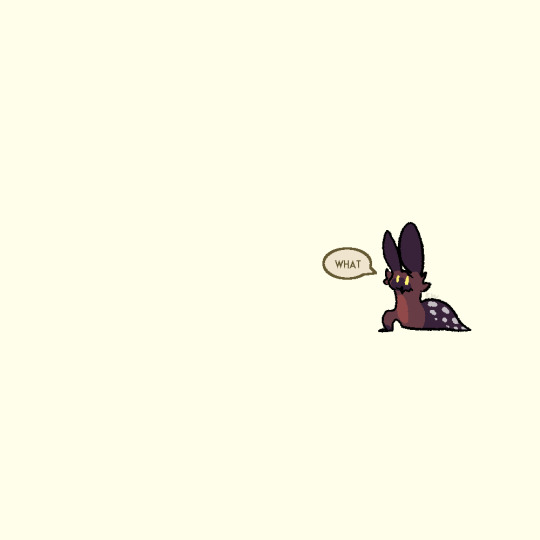
#rw voidlands#rwvl ask#rwvl fennel#OH MY GOD. ANON. THIS IS BEAUTIFUL#im so sorry she doesnt understand a word you said
20 notes
·
View notes
Text
Submitted via Google Form:
Hi, I want my aliens to look human but inside the body they have different/unique body parts/configurations. Like they have two stomachs or a herbivore stomach, several hearts. What if the stomach was above the heart? Or some completely new organ/glands like idk one that can do photosynthesis or that does different jobs like idk the liver/pancreas is a combined one organ or some mix inbetween. I'm not sure where I can make things up in a way that makes sense other than just dropping them in just for fun.
Tex: Stomachs are usually below hearts because of gravity reasons, I believe, but there’s plenty of opportunity to have organs in different positions or different types of organs in a humanoid body according to different ecological needs. What does the environment of the species you’re building for look like? What would they need in terms of adaptations for food, solar radiation, and climate?
Utuabzu: If you're going to go deep into the internal biology of your aliens, you might want to consider their evolutionary history. Anatomy isn't always very efficient, because it doesn't necessarily need to be. A feature just needs to not be seriously detrimental to persist. For instance, our eyes have a blind spot because the blood vessels are actually in front of the cornea, which means that there's a hole in the cornea that the blood vessels enter through. This is a feature shared by all vertebrates (animals with spines), and thus must have been a feature of our most recent common ancestor. Our brains just fill in that gap with guesswork and information from the other eye, and move on. The recurrent laryngeal nerve, which controls the muscles of the larynx (which are required for speech), actually loops under the aorta, and is thus far longer than it needs to be, because deep in our evolutionary past that route was more direct, and this overly long route is not detrimental to our survival and reproduction, so it is not selected against.
Basically, even the weirdest anatomical features exist for a reason, usually either that they are serving a function, used to serve a function but no longer do and their presence doesn't impede survival or reproduction, or are the result of a random mutation and are not impeding survival or reproduction. In many cases, even the seemingly useless features do actually do something, for instance the human appendix acts as a reservoir for gut microbiota that can then repopulate the intestines after an… event that removed much of it. So, my advice is that if you're going to go into detail about the species internal anatomy, ask yourself why any given odd feature exists and if it aids or impedes survival and reproduction, because that's what dictates which features persist and which do not.
Miri: There’s a doctor on youtube who has a done a series of videos on the Games Workshop Space Marines and their anatomical alterations: https://youtu.be/7OXjNpNpWXw?si=zzlhO2FpQbaUuD5v
20 notes
·
View notes
Text


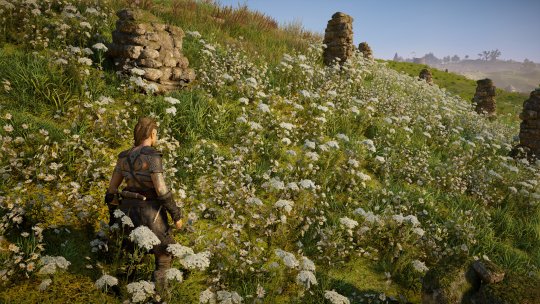
Eivor's herbarium: Page 5 - grasses and yarrow from a cursed zone meadow
~
“From a hill-top meadow west of Grantebridge, where the land breathes again”.
~
Before changing county, I've been thinking about meadows and how agriculturally important they would have been to settlements like Grantebridge or Ravensthorpe. Handily there's a meadow not far from our previous stop outside Soma's longhouse, on a cursed hill-top just west of town.
Cursed zones are small areas on the map where a black roiling fog gathers, horses freak out, and Eivor talks of malevolence and cursed troll magic.
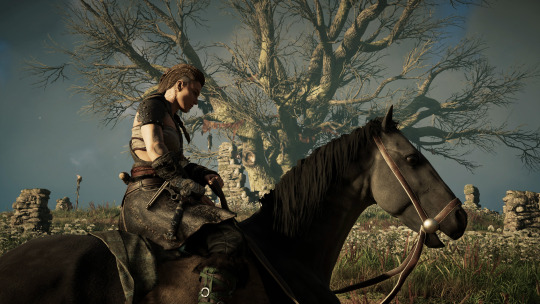
This horse is questioning its life choices...
To dispel the curse you need to find and destroy a skull covered in glowing symbols. Shoot it and the dark fog dissipates, with Eivor saying that the land can breathe again.

The cursed troll magic symbol
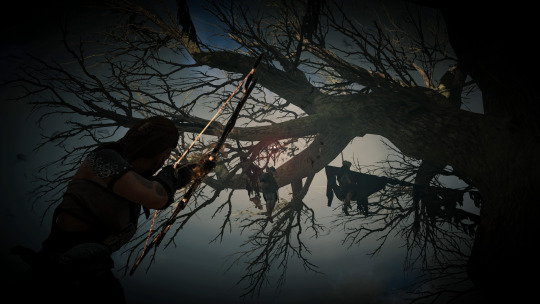
Cursed zones are a slightly odd feature, in that it’s not clear how the ‘magic’ of the curse works. There isn’t an obvious link to Isu tech. We find some notes/snippets of story around suggesting they’re being placed there by Saxons in an attempt to hex away the Danes. In the Wrath of the Druids DLC, the druids are using a recipe that creates hallucinogenic vapor to induce visions of werewolves etc, so the cursed zones could work in a similar way, with the fog being part of the mechanism. But it’s not clear to me unless I’ve missed something.
However they’re supposed to work, cursed zones are good places to find fungi, plants, and honking great big trees. So I quite like them. (I know some gamers hated them and felt they were pointless collectibles; if that’s you, maybe some video game botany will improve them?!)

Aerial view of the hill-top cursed zone west of Grantebridge
The hill-top cursed zone west of Grantebridge has a particularly nice view from above and is surrounded by meadow. Since Eivor is helping run a settlement with farms, I’m sure she’d appreciate the importance of hay meadows to agriculture, and as a source of herbaceous plants for medicinal uses.

In the long grass
What is a meadow?
A meadow is an area of grassland where the vegetation is allowed to grow tall and isn’t cut in spring and summer. In late summer/autumn, the meadow is mowed to make hay, which then feeds farm animals over the winter. Until then, cut meadow is grazed by animals (sheep, cows, maybe goats) which poop as they go, dropping some handy fertiliser around the place. When gets too cold and wet for livestock to be out grazing, animals are brought in and fed on the hay, with the meadow left until spring for the cycle to start over again. This is in contrast to pasture, which is grazed in the growing seasons rather than allowing grasses to get long.

The un-cursed meadow, ready for hay-making
Hay meadows are full of diverse grasses and wildflowers. In AC Valhalla we particularly see yarrow, ox-eye daisies, and grasses like Yorkshire fog (4th pressed grass from the left) and meadow foxtail (2nd from left.)
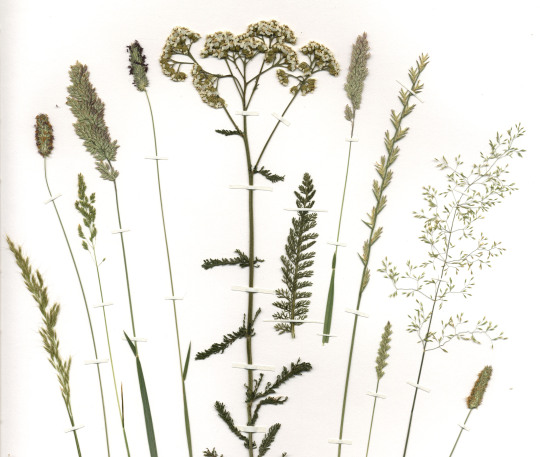
On this page I’ve centred yarrow, mainly because I’m saving the daisies for another page! The grasses are from a couple of square metres in my back garden that I keep as a veeeery smol meadow. I’m lucky enough to have some outdoor space, and my priority in life is generally insects. So I leave some grass to get tall, and encourage a range of local wildflowers and grasses that serve as food for bees, moths, and beetles. In the un-cursed meadow, Eivor might have also seen clover, yellow rattle, lady’s bedstraw, and I’d bet on sweet vernal grass and crested dogstail too (3rd grass from the right.)

Ox-eye daisies in my local cemetery meadow
Hay meadows are an amazing reservoir of wild plant and insect species, but are now a rare habitat. Apart from the obvious changes in agricultural practice, capitalism doesn’t value biodiversity in spaces it could build on, extract from, or intensively farm the crap out of. But hope is not lost for meadow species. Many conservation organisations here work with farming communities to restore former meadows or to create new ones. Churchyards and church lands that haven’t been developed are also important spaces for meadow preservation – and in AC Valhalla we see meadows around the monastery at Meldeburne.
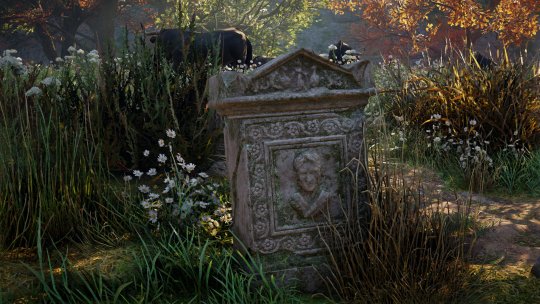
Meadow grasses and flowers around Meldeburne monastery

Yarrow (Achillea millefolium)
Super-common and very tough, yarrow is a component of meadows but is found anywhere grassy – it’s found in lawns and verges all over the UK. In my area you'd be hard pressed not to see any in summer.

Yarrow in my backyard
Feathery, finely divided leaves gave it another common name, milfoil or millefoil, meaning 1000 leaves. It has clusters of small white or pinkish flower heads with an interesting structure. The flat-topped clusters of flowers look like they’re made out of daisy(ish) shaped individual flowers...

...But take a look at those daisy shapes and you’ll see that each is actually a cluster of many smaller tiiiiny flowers that just LOOK like a daisy. The centre is made of a bundle of tube-like ‘disc’ flowers that have 5 petals fused together. These are surrounded by a few ‘ray’ flowers, each with one large petal. So cool!

Yarrow: flowers inside flowers
Ecologically, it’s an important source of nectar and pollen for bees, and a food plant for many other insects, including moths and beetles. Some cavity-nesting birds use it as lining material. I encourage it to grow in my lawn along with clover, self-heal and black medick, because it’s a lot hardier and more drought tolerant than any lawn grass.
Historically, yarrow used to be used medicinally to staunch bleeding, but weirdly was also called ‘nosebleed plant’ because of a myth that it caused nosebleeds. It also used to be used as a good luck charm.

Yarrow and ferns
I'm going to move onto the autumnal ferns of Ledercesterscire for page 6, but I'll probably come back to Grantebridgescire for some of the other mysteries.

#eivors herbarium#Eivor's herbarium#video game botany#videogamebotany#ac valhalla#assassins creed valhalla#assassin's creed valhalla#lady eivor#eivor wolfkissed#eivor varinsdottir#botany#plants#pressed plants#book herbarium#herbarium#meadows#grasses#yarrow#virtual photography
43 notes
·
View notes
Text
Ea, Our Second Chance (13)
13. Anatomy of Diplostomia
(Index)
(< 12. Species study: the Kurukshetran springbear)
(> 14. Reproduction of Haematophyta)

(full image)
A general diagram of the anatomy of Diplostomia, a class of animal-like organisms from Planet Ea, to which springbears belong among others.
A brief summary of the body's fundamental working:
Food is mechanically demolished by the maxillae (cutting, crushing, piercing) and radula (grinding against palate) and swallowed, proceeding into the stomach. The secretions of the salivary glands begin an aggressive digestion.
Ingested food is digested into the stomach; the isolated nutritive molecules pass into the caeca and are absorbed into the lymph-filled body cavity, or haemocoel, in which they float. Liquefied food can pass up to a few hours in the caeca to be fully assimilated.
With the expansion of the posterior hearts, the aorta draws lymph rich in nutrients from the posterior haemocoel.
The contraction and expansion of hearts pumps lymph through the aorta in posterior-anterior direction, i.e. from back to front.
Air flows through the dorsal scutes into the dorsal lacunar system; oxygen filters into lymph-filled lacunae and from those into the aorta. The scutes may actively pump air into the empty lacunae. They can also lock down in place for improved defense, but when this occurs, the diplostome cannot breathe.
The anterior hearts pump lymph now rich in both nutrients and oxygen into the anterior haemocoel, where the gonads and encephalon (the organs that require the highest-quality lymph) are located.
Some sugars and oxygen pass from the haemocoel through the wall of the Vindhana organ into the hydromuscular fluid.
The Vindhana nodules within the reservoir wall produce and release immunitary cells into the fluid, as well as reabsorbing old ones.
Muscular action recalls the hydromuscular fluid (with its sugars, oxygen, and immunitary cells) to muscles in action.
Carbon dioxide and metabolic waste are released from all organs into the haemocoel (directly with the lymph, or again via hydromuscular circulation and the Vindhana organ).
The released carbon dioxide is present in the lymph as it's drawn into the aorta, and is expelled through the lacunar system as it flows along.
Metabolic waste in the haemocoel is absorbed by the caeca to be concentrated in the stomach in a dehydrated form and expelled together with undigested food remains through the mouth.
Of course hydraulic muscles are not simply bags filled with liquid: that would make them too vulnerable to infection or rupture. (Imagine the consequences of the cyanothrombovirus, which causes clotting of the hydromuscular fluid, if a single clot could stop circulation in a whole limb.) Its internal tissue resembles the pulp of a citrus fruit, with thousands of millimeter-sized cells, each individually swollen or emptied of fluid by the action of its membrane; with the exception of the color, as the concentration of cyanoglobin gives it a blue-green tint (as well as giving to flipped meat the coppery taste so appreciated in Svobodan cuisine).
The basic principle is simple: the inside of the cells is much saltier than the outside, and so tends to draw water in; water from the lymph flow into the cells from outside through the permeable membrane, causing them to swell. When a nervous signal to relax comes, the salt is sequestered in special vacuoles, stopping the inflow, and the muscle's tough elastic sheath squeezes the water back out. When an Ean animal dies, it goes through its own version of rigor mortis, as the relaxing signal never comes again and all muscles swell to their full capacity.
The separation of cells gives Ean hydraulic muscles a versatility that even our own fibrous muscles cannot quite achieve. By allowing the entrance of water only in selected cells, a muscle may bend or twist around its axis. Purely muscular structures that could be likened to tongues, octopus arms, or elephant trunks are common among geopentamerans. Projectile tongues, which on Earth are found only in a few lizards and amphibians, are ubiquitous on Ea, as they can be operated simply by filling them with fluid, like a party trumpet. It's interesting, therefore, that their limbs actually imitate the zig-zag jointed structure of the vertebrate bone-and-fibrous-muscle arrangement. This may be a matter of energy economy: when a limb is divided in rigid segment, motion requires muscular activity only at the joints, rather than along all its length. Bone-like supports introduce the mechanical efficiency of levers.
Still, in general, soft muscle-like structures are more effective in pulling than in pushing, as, without the support of rigid bone, they would squash or bend against a solid object. Pushing against the ground is precisely what is needed to keep a body upright and to walk. Here the exoskeleton (the outer shell) of geopentamerans comes into play: thanks to the elastic fibres pulling the calcite scales together, the exoskeleton locks into place and prevents deformation of the limb. The hydraulic muscles pushing against a solid surface have no direction to expand but forward. The same principle requires the thrusting stylet of fluid-eating geopentamerans to be encased in a rigid shell. [...]
Besides carrying oxygen, cyanoglobin also allows the hydraulic apparatus, woven as it is with a complex web of vessels, to serve as a secondary circulatory system. It's long been a mystery how animals so fierce as the scissorwolves, so nimble as the sedgetails, or so active as the kirikits, could make do with such an inefficient method of breathing. The lacunar system, after all, half-heartedly pushes oxygen into a cavity where it passively diffuses into the viscera; Simplostomia, at least, have proper lungs! In fact, the hydraulic apparatus truly shows the One's cleverness in reusing the same structures for multiple purposes: the swelling of hydraulic muscles, by pumping fluid in the regions of greatest activity, concentrates oxygen and nutrients precisely where they are needed.
– Ashoka Jansen, The Stones Call His Name: Sermons of Natural Theology, Uzuri, 281 AL
#speculative biology#speculative evolution#xenobiology#alien life#worldbuilding#my work#ea our second chance
52 notes
·
View notes
Text
maybe i do: ch 8 red hair, teary eyes
read ch 7 here ♡ read ch 9 here
Link was growing increasingly anxious at the thought of bumping into Sidon right now. He wasn’t sure how to feel about what had happened yesterday. Or well, two days ago since apparently he slept for OVER A DAY?? That was concerning in itself. Link never slept more than 6 hours and it was always broken up into smaller chunks of time. He can thank a lot of things for his gods awful sleeping habits. While Link appreciated having Sidon to lean on (sometimes literally) during flashbacks and panic attacks it made him feel small and weak. He needed to get over his ego at this point. Literally speaking he was small which had its perks at times, but he was by no means weak. Years of being a knight and hero had made him abnormally strong for his size. The fact that he was strong didn’t help him from feeling ever so fragile during a flashback. He couldn’t even control his own emotions now.
But being with Sidon made everything feel just a little bit better. He made being small feel like not such a bad thing. It felt so nice to have someone who wouldn’t judge Link for not putting on a face and acting like everything was fine. Everything definitely wasn’t fine.
⟡ ⟡ ⟡
It was time for some fresh air. Link had been asleep for so long he felt like he’d lost weeks of time, not just a day. His muscles felt stiff and he was beginning to get antsy just sitting around. Time for a hike.
Link loved rock climbing, it was the thrill of having to pull yourself up the face of a cliff with nothing but your physical strength and some climbing gear. Tal Tal peak was the perfect climbing site. It was naturally terraced in some areas which provided good resting spots. The view at the top of the peak was stunning, you could see all of the east reservoir lake on one side and the grotto from the other.
He decided to not take Epona, going back to the stables hurt just a little too much, but he asked one of the stable hands if they could let her loose for a bit so she could roam. She refused to let anyone besides Link ride her. Taking his time to go anywhere was so against his instincts, he either ran, jogged or rode Epona pretty much everywhere during a trip. Around Lanayru he felt less pressure by himself to get everywhere as fast as possible. So he allowed himself time to explore as he made his way to the bottom of Tal Tal peak. He wanted to absorb every little detail about this place. The types of animals and insects that inhabited the area, the species of trees and of course, anything edible.
As much as Link loved climbing and exploring, he loved cooking more. Cooking was a science, an art, and an experience rolled into one. He loved experimenting with new flavor combinations and seeing how they would mix and react with each other.
Link had still reached the bottom of the peak in just over an hour despite trying to take his time. Not like it was a far trek anyways. He pulled out the ropes and stakes from his pack and started to prepare to climb. A shrill scream pierced his ears, was that a kid? It was followed by the hiss and garble of a lizalfo. Link dropped everything, pulling two daggers from each side of him. And this is why Link never went anywhere without some kind of weapon, usually a couple just to be safe.
Fortunately Link didn’t have to force himself to speak as the Hylian kid scampered behind him. He dropped into a fighting stance, eyes locked on the lone blue lizalfo. He waited for the monster to make a move before drawing it away from the kid. He motioned for them to run as he lunged at the lizalfo, landing a slash to its ribcage. It tried to move past Link in the kid's direction, but Link didn’t allow that. Taking the opening the lizalfo had created he plunged one of the daggers into its thick, scaly neck. He twisted the blade, driving it in deeper as it fell to the ground making a final gurgling noise before death came and claimed it.
Double checking the monster was actually dead, Link scanned the area for signs of other monsters. He ran after the kid to make sure they were alright. They hadn’t made it very far, having tripped over a rock and skinned their knee. The poor thing was sobbing, covered in dirt and blood from their knee injury.
“Are you ok?” Link wasn’t thinking when he automatically began to sign. Lots of times children didn’t know Hylian sign so he had to mouth the words slowly in hopes they could figure out what he was saying. Purah had made a tool on his Sheikah slate that could speak whatever he typed out but of course he had forgotten that in his guest rooms.
Link was visibly shocked when the child nodded and signed back, their hands trembling and clunky. “Thank you Master Link!” He smiled and patted the boy’s head. The kid’s lip quivered, about to cry again.
“It’s ok now, the monster is all gone. You’re safe with me.” Link fell backwards, the boy leaping into his arms. Link smiled and hugged him, rocking the boy until he stopped crying. “What’s your name? Are your parents close by?”
The boy shook his head, “I’m Lobin. They travel without me. I live all by myself in our house.” He was trying to put on a brave face for Link but his hands were shaking harder now. Link stood up, letting go of him. The boy whimpered, clinging onto Link’s legs. “Please don’t leave me too.”
This broke Link, a little kid, probably only 6 or 7 years old who had been left on his own. Did his parents just expect the kid would be able to survive on his own? Fucking bastards. He had shoulder length bright red hair pulled back, tangled but mostly clean. He could at least keep himself clean but his clothes hung off his body. Link wasn’t sure if the clothes were just too big or the kid was malnourished, he assumed the latter.
Link decided it was best to take him back to the Domain and get him checked out by a nurse just to be safe. His climbing gear and pack were still back where he left them but Lobin was more important now. “I’m going to take you back to where I’m staying, ok? We can get you checked out by a nice doctor and give you something to eat.”
Lobin nodded slowly, his big blue eyes staring at Link as if waiting for him to do something bad. He decided Link was trustworthy and climbed on Link’s back when he motioned for Lobin to do so. This time, Link moved faster, at a brisk pace. He didn’t need any more bullshit to happen to this poor kid.
⟡ ⟡ ⟡
Lobin was excited but clearly still shaken from the run in with the lizalfo. Link set the kid down in the infirmary bay, he stayed close to Link as he looked everywhere. His eyes dazzled, staring at the large pillars of white marble that supported the inner domain building. Link looked at the kid who, if it had been a normal day, would probably be running around exploring every corner of the inner domain. Probably like Link had. He knew he had been here when he was younger, escorting Zelda as her knight but this is just what Sidon had told him. He remembered none of it.
“Master Link! Oh, my! Did you get hurt?” One of the nurses approached, her eyes drifted down to Lobin who partially hid behind Link. “And who might you be?” She smiled gently, stepping closer, Lobin buried his head in Link’s tunic, pushing himself as close to Link as possible.
“This is Lobin, found him getting attacked by a lizalfo near Tal Tal peak.” Link smiled, looking down at him. “He busted his knee running from the fight.” Link tried peeling Lobin off of him so the nurse could take a look at his knee. Lobin groaned, shaking his head furiously, head still mostly buried in the tunic. Link tapped his shoulder, gave him a quick smile, “This nice Zora is gonna patch your knee up and make sure you’re doing ok.”
“Nooo.” Lobin mumbled, this was the first time Link had heard Lobin speak, after him using Hylian sign Link automatically assumed he was primarily non-speaking. Lobin released Link from his tight grasp, “Please come with me.”
The nurse laughed quietly, “It’s alright Master Link, you can come with. I’d like to check out that gash on your bicep too.”
Link lifted Lobin up on the exam bench. He sniffled, the adrenaline must be wearing off now. The nurse dabbed his wound clean and bandaged it up as quickly as she could. Lobin put on a brave face but winced every time she touched him. Link couldn’t quite place it but he felt a connection to the kid, like they shared similar experiences. Like he understood living on his own as a child.
“Not so bad was it hun? I even have a prize for being so good!” The nurse pulled a piece of candy out of a drawer and handed it over to Lobin. He looked up at Link, as if asking for permission. Link smiled and nodded, that small look. It showed more pain than a child should ever know.
⟡ ⟡ ⟡
Lobin had become Link’s shadow over the past 3 days. He couldn’t handle going anywhere without the hero, crying whenever anyone even thought of taking him away from Link. The inner Domain staff had taken to calling Lobin, little master, after the hero’s honorific given to Link. Often, Link would end up carrying Lobin on his back or on his shoulders. Lobin’s knee had to be given stitches, the wound ended up being more severe than the boy had let off.
With as much time as Link had been spending with Lobin he was starting to get attached. The kid was endearing, but didn’t seem to trust anyone other than Link. After a few hours on the first day of Lobin staying with Link, he became increasingly concerned for the boy. After a bath and a fresh change of clothes it was evident how thin and malnourished he looked. Link took this into his own hands and came up with some hearty meals to feed Lobin. If this boy was going to be attached to him at the hip, by the gods he’ll at least be well fed. Lobin took to Link’s cooking immediately, eating several portions at each meal. Link hoped this would help him at least a little bit.
An attempt with sleeping arrangements had been made. A smaller bed had been brought in for Lobin, but he refused to sleep without Link to curl up next to. Link learned that they both were bad at sleep. Lobin had horrid nightmares, same as Link. But sleeping with another warm body by your side was a small comfort to Link. It made a memory of him and Zelda pop up. He used to tell her stories late at night when she woke up from a nightmare or just couldn’t sleep. They would end up falling asleep together and waking up, both with equally messy hair.
⟡ ⟡ ⟡
“Ok! What for breakfast today Binnie?” Link had definitely gotten attached to this kid. He had somehow wound up creating a nickname for Lobin, ‘Binnie’. Lobin found this to be the best thing that’s ever happened to him. Getting a personal nickname from the HERO of Hyrule? Link could never understand just how happy this had made Lobin.
Link thought too much. He thought too much and was overthinking this. Sidon hadn’t shown up since the whole ‘sobbing at a horse stable because Link can’t get himself together’. What if he’d scared Sidon away with his flashbacks? He had just started to open himself up to Sidon, and he fucked up yet again and Sidon was gone for good. Link wasn’t worthy of Sidon’s time anyways so it was fine.
He was fine.
Everything was not fine. Link snapped out of his thoughts to the smell of burning meat. Fucking hell. He had burnt the ham slices Lobin had requested for breakfast. Thinking about Sidon. Why was he thinking about Sidon?
“Here you go buddy, eggs and no ham.” Link sighed and set down the plate.
“Oh. You burnt the ham? I thought your cooking was magic, how do you burn something when you’re using magic?” Lobin pouted, poking his eggs before taking a tentative bite. His eyes widened and hummed happily. Clearly Link’s magic wasn’t entirely lost. Unlike he was.
There was something Link was missing. Something about Sidon he wasn’t getting. Something so enigmatic about his feelings towards Sidon there was no way Link was gonna figure this out.
Oh.
Wait.
Fuck.
Fucking hell, Link had connected the dots. He couldn’t believe it. There was no way.
Link was gay. Gay and in love. Only the love part was new. And who did his gay ass have to fall in love with? King Sidon. Of the Zora. That was married. To a woman.
This was the worst thing that had ever happened to him.
Fuck all the trauma, pain and suffering. Accidentally falling in love with a married man was the absolute end of the line. This was a completely unrequited love. It had to be. He couldn’t fall in love with a married man! Apparently, Sidon was more than just his supposed close friend. He was his supposed crush.
Fuck.
Link nearly had a heart attack, Lobin tapped his arm impatiently trying to get his attention. “What are you thinking about? Your face is red and you look like you wanna cry. Did I make you upset? I’m sorry Master Link!”
Link frowned, well fuck he made the kid upset. “No, of course you didn't upset me, Binnie. I was just thinking is all.”
The little boy, pouted not satisfied, “Your face’s all red and your eyebrows are all scrunchy like this!” Lobin furrowed his eyebrows, and puffed his cheeks up.
Link blushed more, how did he explain this? He had a full on crush on the Zora king! He barely accepted that fact himself. Explaining complex feelings had never been his strong suit but even then, this was different and more complex. More so than he wanted to fully admit.
“Come on dada! Tell me, tell me!” Lobin paused, realizing what he had just called Master Link. Uh oh.
Link stood there, blinking hard. ‘Dada’? So much was happening all at once. He didn’t hate the idea of being a parent. Kids were amazing and fun to interact with. But him? A dad? Just that was a lot to process. There wasn’t time to process this now. He must’ve looked mad or upset, Lobin had burst into tears.
“–Sorry!!” He signed the word over and over. Link took no time in hugging the small child, rocking him gently. This was all his fault. He stroked Lobin’s hair and kissed the top of his little head.
He was apparently a dad now.
#legend of zelda#the legend of zelda#tloz#tears of the kingdom#breath of the wild#maybe i do#sidlink#loz#link#link has ptsd and surviors guilt#link is nonspeaking and uses hylian version of sign language#sidon x link#mute link#nonspeaking link#mew fics
6 notes
·
View notes
Text
Earning the Nickname
Tri-Tober
Fanfic shorts
Prompt 2: Stampede
Setting: Trigun Stampede with Badlands Rumble references.
Rating: General
Summary: And this is why you might see a wild toma someday.
Prompt 2: Stampede
Earning the Nickname
There was a time before infamy for Vash – a time for first crimes.
He'd come to stay in small towns during his early days wandering the sandy planet in his searches for Nai and seeing to the welfare of his sisters, who would call to him in his dreams. Tomas were invaluable friends then, pack animals and mounts that were the hardiest of hardy creatures, save perhaps the worms, but far friendlier to humans and human-like Plants. They had been brought over from old Earth, stored as embryos and Vash was never certain if they were bred down from something called an “emu” (which had apparently won an actual war that humans had waged on them once in the wilds of their own territory), if they were genetic-constructs with origins similar to Plants or if they were a project to bring back some extinct species, some kind of “elephant bird” that Rem had once told him about and that he couldn’t wrap his head around imagining. In any case, Brad back Home had showed him how to care for them. You had to keep your mount happy if you had any chance of coming back Home from a trip to the desert, after all.
It wasn’t very long before the survivors of the Big Fall started using their valuable steed-birds for other purposes. Eggs as a food source were, of course, a given. Meat followed afterward. While Vash could never imagine eating his own mounts, he understood the survival needs of the population. It also, he hated to admit, took some pressure of the Plants to have livestock around. It took him a bit longer to take to eating toma-meat himself, but when he did, he found that he’d liked it. It could be dried rock-hard into something that could be taken off a fossilized chunk in slivers and made for a good long-term, long-distance ration that was surprisingly filling for how little one could flake off with a knife at a time.
Regardless of knowing what these cute, big goofy birds tasted like, Vash could not stand to see them in any kind of ill-treatment. Even birds doomed to slaughter deserved to be fed and watered in the meantime.
So, when a young Vash, one who was not yet the subject of pursuits and wanted posters came upon a small ranching town where he saw a pen of toma panting and swaying, rolling and suffering in the dust from thirst-induced bloat and inquired about empty troughs and got an answer from a farm owner that it just didn’t matter if the birds were watered because they weren’t long for this world, anyway – “We’ll just take the fresh ones and any that die in the pen can be used for leather,” well, that didn’t quite sit well with Vash.
The town had a Plant-source reservoir not an isle away.
He took out his big gun and blew off the locks on the main gate.
“Oops, looks like your fence is broken!”
“Why you!”
Seeing freedom and smelling water, the toma flowed as one. The ground shook and people dove for doorways or looked out of windows at the dust and covered their ears for all the squawking.
After the creatures had made their way to the reservoir and drunk their fill, none of the resident ranchers were able to round up a single one.
The place became known for its population of wily feral tomas that lived among the canyon rocks and the scant flora scrub eating small worms and stealing garbage. The town was renamed from something forgotten to Big Bird Gulch. There was a war fought against them to try to rein them in, but in the end, like their ancestors before them, the toma won. They retained their right to live and to continue to be a local nuisance. In exchange for all of the loud nighttime trash-scavenging outside the homes, businesses, bars and brothels, they became quite a tourist-attraction. Artists in the town painted pictures and made little clay sculptures that sold well as souvenirs. People from all around brought money into Big Bird Gulch going on tours around the scrub in hopes of catching a glimpse of one of the world’s only “wild toma.”
And a young man named Vash became Vash the Stampede ever since.
#trigun#trigun maximum#trigun stampede#badlands rumble#vash#vash the stampede#toma-bird#tomas (trigun)#tritober#tri-tober#inktober
14 notes
·
View notes
Note
I would love to hear about your experience as a park ranger! I'm trying to shift my work into park stuff (and nature stuff in general) and I don't know much about park rangers
Aaa hello!
So I was an interpreter at a state park, it was a small park with nothing too dramatic happening (@wild-west-wind is a ranger at a National Park and has more experience than me and talks about it in their park ranger tag). The best part about my park was that it was in a fairly suburban area, about an hour away from a major city, so I feel like it was really valuable for people to find this area of nature that was preserved right here near their homes. One of my goals was to show them that some of the nature there could be found at their own homes as well.
Idk what kind of things you want to know and whether I have the experience to answer it, but I want to say that my main goal was to connect people both to nature in general and, as I said, the nature around them at home. The suburbs can both feel like and actually be somewhat of a wasteland sometimes (this is a main theme in the book of short stories I’m working on). But nature cannot be erased entirely. People’s lawns are made of manicured monoculture grass, but that grass is still a plant. There may be a small group of trees on the corner, but they’re still trees. Butterflies, bees, and other pollinating bugs still come to the exotic and ornamental flowers they plant in their yards. Coyotes, raccoons, and foxes sniff around their trash cans at night. Birds, squirrels, moss, lichen, and countless bugs live in those few trees on the corner. Hawks sit on the backyard fences, and ospreys and herons fly overhead, commuting from fish pond to reservoir. And that’s only the life we’re capable of seeing. The local ecosystem may not be healthy, but it’s always there.
I want to connect people to that kind of thing. I want them to pay attention to the plants and animals that share their neighborhood. They don’t even have to learn species names, it’s enough just to notice that there’s moss on that tree or that there are multiple types of weeds in the crack on the sidewalk or that that one bush is always full of birds in the morning. And the start of that journey might be having me point out wildlife in a slightly more wild setting, teaching them to notice and think about and wonder about various different things. If I point out how the male dragonflies are guarding prime egg-laying spots if you only stop to watch, maybe they’ll wonder what else they can notice if they stop and pay attention to the bugs in their yard. If I show them the little spring flowers under their feet that they didn’t even notice, maybe they’ll look for them as they walk to their mailbox at home. If I teach them to listen to the alarm calls that birds make, maybe it will unlock a whole new soundscape in their backyard.
Connecting to nature is important both for conservation and for our own physical and mental health. The more we care about something, or at least understand it, the more we protect it. People don’t need to come away from my hikes loving vultures, but if they come away understanding that every living thing is connected in our ecosystem, that’s what’s important. They don’t have to like vultures to see the importance of that interconnectedness and consider their own role in it (although liking vultures is always encouraged). And not only is our health linked to the health of the planet, we are also a species that evolved in nature like every other and it is genuinely good for our health to engage with it. Exercise is one thing, but then also just being in the sun improves the quality of sleep you get and increases the production of dopamine and serotonin in your brain. Exposure to nature makes you more relaxed. Being aware of the living things around you is mentally stimulating and makes you feel less alone, and more engaged with the passage of time and the things going on around you. This is why nature accessibility is so important, both in terms of having natural spaces available to people of all income levels and in a way that works with our capitalist work and life schedules and in terms of making it accessible to disabled people, especially those who can’t leave the house.
(Side note, I really admire how @geopsych gets people that nature exposure and connection through their photography)
So idk, that’s my mission as a nature educator. Yes, I love infodumping and getting to show people coyote pelts and baby bugs and all the little nature secrets. But that’s the larger goal I carry beyond the self-satisfaction of talking about nature facts. It’s a very big goal but like everything in an ecosystem, little impacts add up, and I hope I’ll be able to make lots of those little impacts throughout my life.
5 notes
·
View notes
Text
It pains me seeing posts going around saying stupid shit like "possums and racoons can't give you rabies" because it's 100% sure that someone will trust that information and not handle a wild mammal properly
ALL MAMMALS ARE SUSCEPTIBLE TO A RABIES INFECTION!!!!!!
there's some species that are more important because they are wild reservoirs of the virus, but that doesn't mean you can just go around trying to touch a certain species because they "almost never get rabies".
There's a pre-exposure vaccine. I don't know how it works outside my country, but here even as a vetmed STUDENT you are REQUIRED to have this vaccination or you can't participate in certain classes. This vaccine is also required to zootechnicians, zookeepers (or anyone that works somewhere like a zoo) and rural producers are also encouraged to get vaccinated due to the close proximity to animals.
Here we are very very blessed to be able to get the post exposure vaccine for free if we happen to be bitten but that's not a reallity everywhere. SO DON'T TRY AND TOUCH WILD MAMMALS BECAUSE THEY CAN HAVE RABIES
#this makes me so mad#venting#jesus fucking fuck#just random thoughts that i couldnt put really in order#rabies#pls be careful it 99% sure will KILL YOU
9 notes
·
View notes
Note
Can I perhaps request a short fic about the Ravens and the Golden Garden/Targent for PL4 Day (I love those crazy kids)? I had this somewhat odd idea that Swift just adopts any kid with a bird name because he's quite literally a mama bird in my eyes...(Crow, pack your bags, lmao).
((Thank you for the request! I’m sorry this is a day late and it’s kind of open-ended but it was already longer than intended and I needed to finish it.))
Title: The Raven and the Swift
Description: The Black Ravens aren’t giving up the Golden Garden without a fight. Swift is sent to infiltrate Misthallery.
Set: After PL4, but before Miracle Mask and Azran Legacy
Spoilers: For PL4
Warnings: Referenced character/animal death, Swift carries a knife
Swift— dressed in white trainers, khaki cargo shorts, and a red floral shirt— made his way up to the Golden Garden.
While his ‘tourist’ disguise was intended to portray a casual demeanour, he admittedly (and ironically) would have felt more at ease in his Targent uniform. His face felt particularly exposed without his scarf and his sunglasses, but his dark brown contact lenses would have to do for now.
His targets were all too familiar with Targent’s appearance in Misthallery.
Swift was here under strict, classified orders from Commander Bronev. The mission he had been given required the upmost stealth and sagacity.
If Swift was recognised, he would be denied access to the Golden Garden, and the Azran site would remain out of Targent’s control.
Thus far, Targent’s best efforts to secure the garden had been impeded by a gang of ruffians wearing white bird masks and ragged black robes.
Despite Swift’s suggestions to deploy the assassins, Bronev had insisted that it was to be a bloodless, clandestine infiltration.
They didn’t want to alarm the local residents or the authorities… unlike Jean Descole, with his ridiculous attempt to demolish Misthallery over a year ago.
Had this ‘Black Raven gang’ been hired by Descole? The Ravens’ costumes certainly resembled Descole’s, with their white masks and billowing dark attire…
Not to mention, the Ravens had Descole’s ‘Spectre Robot’— with which, they had managed to drive Targent out of Misthallery so far…
Bronev was right; Targent couldn’t just invade the garden, guns blazing. Then their agency would look no better than Descole or his underlings.
Someone needed to take the garden right from under the Ravens’ noses. Someone like Swift.
Swift frowned as he joined the queue of visitors waiting to enter the Golden Garden. They were all being corralled like cattle along a canal, which had been emptied of water along with the reservoir.
Apparently, the giant lake-dweller that had once inhabited Misthallery had destroyed the flood gates and uncovered the entrance to the Golden Garden.
The creature had given her life, and (as rumour had it) allowed a sickly young girl to recover with the garden’s pure air.
Why should the residents of Misthallery alone be able to capitalise off the Golden Garden? The gifts of the Azran should be shared with the world!
The majority of these people, like Jean Descole, would have no respect for the Azran’s legacy; just lookat how they had treated the aquatic creature— the last of an ancient species. (They were known as “Lagushi”, in the ancient Azran language.)
If Targent had arrived in town before Descole, they would have temporality captured the creature, ensured her safety while they studied her, before releasing her back into the Golden Garden.
Swift would have made sure of it—
“Get your very own Loosha, right here!”
Swift raised an eyebrow at the salesperson hollering from a wooden stall on the bank of the canal. The person, along with their two colleagues, were all sporting Black Raven costumes.
The Ravens were gesturing to the blue ‘Loosha’ toys and other mechanise out on display. It seemed they were profiting off Loosha’s sacrifice. (How tactless…)
One red-haired woman purchased a T-shirt from the stall. She ran past Swift, whooping.
Reluctantly, Swift left the queue to approach the Ravens’ stall.
“Greetings, curious traveller!” called the Raven who had been hollering earlier. (They actually sounded quite young, now that Swift considered it.) “May I interest you in a Loosha friend?”
Swift hummed, perusing the wares with a sceptical eye. “Is that really what ‘Loosha’ looked like?”
The speaker replied, “‘Course it is—“
“We saw her up close,” a slightly taller Raven bragged.
“Did you now?” Swift drawled.
“Yes! We helped her open the flood gate—“
“That’s enough,” a third Raven hissed. They shuffled to the front of the stall to stare at Swift. “If you’re not gonna buy anything, then buzz off!”
“I will buy… this,” Swift said, pointing to a glittering grey-blue stone supposedly from the Golden Garden. He removed a £50 note from his wallet. “And I’m after some information, please.”
He placed the money on the stall counter. The Ravens snatched it up, resembling the scavenger birds they were named after.
“How can we help you, Sir?” the third Raven chimed, all traces of rudeness vanishing from their voice. Their associates observed Swift curiously.
Swift put the stone in his pocket, carefully pondering his next words. He gestured to the Ravens’ robes.
“What was the inspiration behind your… Black Raven apparel?”
The Ravens hadn’t expected that. The trio glanced at each other— engrossed in some silent discussion Swift had no part in. After a moment, the third Raven (the apparent leader) nodded.
The leader asked Swift, in a conspiratorial tone, “Have you heard about the Bird of Illusion?”
“Perhaps…” Swift hummed. He had read about that particular Azran legend, but how much could he reveal without raising the Ravens’ suspicions? “Is it linked to the Golden Garden, by any chance?”
“Indeed! The bird was said to lead people into the garden— but only those rare few who proved themselves worthy!”
“Worthy?” Swift snorted. Anyone could enter the Golden Garden these days…
Looking back at the visitors’ queue, Swift was annoyed— albeit, unsurprised— to see his space had been taken. At this rate, the garden would be closed before Swift could get inside!
He huffed. Behind him, Swift heard muttering from the Ravens.
Then, the lead Raven said, “Lost your place in the line?”
“Obviously…” Swift rolled his eyes back to them.
The leader whispered, “What if we could offer you a private tour of the garden?”
“Really?” Swift’s eyes narrowed. Was this a scam? Or an attempt to catch Swift off guard?”
“Really, really!” the leader breathed. “For £100–“
“I already gave you fifty,” Swift grumbled.
“Seventy, then! That’s my final offer,” the leader bargained. They offered Swift their long flowing sleeve.
Swift shook it.
“Meet here at midnight,” the leader muttered.
-
Swift knew he could very well be waltzing into a trap.
The Black Raven may have been inspired by the Bird of Illusion… but Jean Descole was familiar with Azran myths too. It would be in keeping with Descole to make an imitation of such a myth— like he had done with the spectre.
Consequently, Swift wasn’t going in unarmed.
The mist might not have been as bad as it was during the ‘spectre’ attacks, but it was still thick enough to cut with the small knife Swift carried in his shorts’ pocket. Really, he hoped he wouldn’t have to use it…
Still, his hand hovered over his pocket as he crept up the hill to the former-reservoir.
He had left early— intending to arrive before his ‘guide’— but there, waiting next to the canal, was the Black Raven.
The Raven was wielding a lantern, which they lifted upon Swift’s approach. Swift felt like he was about to be led into the afterlife by a ghostly guide…
No. Whatever happened tonight, Swift was going to walk away from it in tact.
“Finally,” the Raven snorted. It was the leader from earlier. Once again, Swift was struck by how youngthey sounded— no older than sixteen, surely.
Swift shrugged. He gestured to the entrance in the dam wall. “After you…”
The Raven gestured back at him.
“No, please— after you…”
Slowly, Swift turned towards the entrance. Swift sensed the incoming attack. He ducked as the lantern swung over his head. Spinning on the ground, Swift kicked the Raven off their feet.
The Raven cursed and landed on their back.
When Swift glared down at them, he saw their hood and the bird mask had come off. A boy with dark blonde hair was blinking up at him, with one dark eye not concealed by his fringe.
The boy wheezed. “You’re one of them, aren’t you?”
“Do you work him?” Swift demanded. He had removed his knife and was now pointing it towards the youth. “Jean Descole?”
“What?” the boy gasped. It was almost a pained laugh. “‘Course not! That nut-head tried to destroy our town—“
“Then explain why you still have his machine,” Swift hissed.
“Uh…” The boy struggled to sit up. “D’you mean the Spectre Bot? We nicked it from him—“
“And you’ve been using it to fight my associates ever since!”
“Well— yeah…” Frowning at Swift, the boy clambered to his feet. “Did you really think we’d let some other nut-heads take the garden? After Loosha died for it—?”
“My… organisation has no quarrel with you or your little gang,” Swift reasoned. He lowered his knife. “All we want is to ensure—“
“You just attacked me!”
“In self-defence after you attacked me!”
The boy huffed and crossed his arms. “So… what now? Are you gonna kill me?” Under his bravado, Swift could see he was shaking slightly.
“…No,” said Swift. He pocketed his knife. “What would be the point in that?”
Relief flashed through the boy’s one visible eye.
Swift turned his head towards the dam wall and the garden beyond. “Instead, I have a mission for you and the rest of the Black Ravens.”
“A mission?” The boy’s tone was still guarded, but Swift detected a hint of curiosity.
“For now, my agency will leave the garden alone— trusting that you and your friends will guard the site from Jean Descole.” Swift smiled and held out his hand. “Do we have a deal?”
“Do I have a choice?” the boy muttered.
“The only other choice is that I will send in reinforcements to secure the garden,” Swift warned.
The Black Ravens’ leader sighed. He quickly shook hands with Swift.
“I’ll throw in three hundred pounds for your troubles,” Swift added.
Bronev wouldn’t be pleased about the price— but wasn’t it worth it to know the garden would be under watch, and Targent wouldn’t have to get their hands dirty?
And what if their agency could gain some new recruits along the way?
The boy hummed, before he agreed, “Deal… Erm, what’s your name? Just in case we need to get hold of you—“
“It’s Swift,” Swift answered. “Yourself?”
He smirked. “Crow.”
6 notes
·
View notes
Text

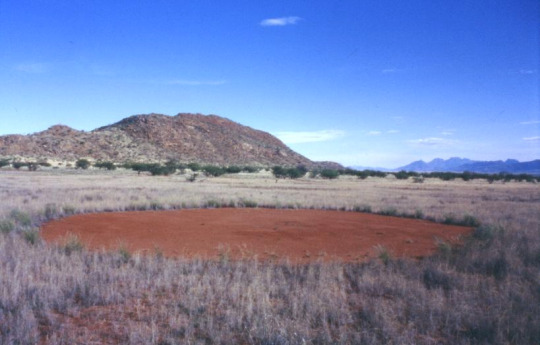
Fairy circles are circular patches of land barren of plants, varying between 2 and 12 metres (7 and 39 ft) in diameter, often encircled by a ring of stimulated growth of grass. They occur in the arid grasslands of the Namib desert in western parts of Southern Africa, and in a part of the Pilbara in Western Australia. Studies have posited various hypotheses about their origins, but none have conclusively proven how they are formed. Theories include the activities of various types of termites, or the consequence of vegetation patterns that arise naturally from competition between grasses.
In 2012, Eugene Moll suggested the termite species Baucaliotermes hainsei and Psammotermes allocerus as the creator of these circles. All rings have been found to contain termite casts, and radar investigations suggest that a moist layer of soil is situated beneath the fairy circles.[10]
In 2013, this theory was supported by Norbert Juergens. Juergens found evidence that the sand termite, Psammotermes allocerus, generates a local ecosystem that profits from and promotes the creation of the fairy circle.[14][15] The sand termite was found in 80-100% of the circles, in 100% of newly formed circles,[14] and was the only insect to live across the range of the phenomenon. Sand termites create the fairy circle by consuming vegetation and burrowing in the soil to create the ring. The barren circle allows water to percolate down through sandy soil and accumulate underground, allowing the soil to remain moist even under the driest conditions. Grass growth around the circle is promoted by the accumulated soil water, and in turn the termites feed on the grasses, slowly increasing the diameter of the circle. This behaviour on the part of Psammotermes allocerus amounts to creation of a local ecosystem in a manner analogous to behaviour of the common beaver.[4]
Walter R. Tschinkel, a biologist at Florida State University, who also researched the fairy circles, remarked that Juergens, "has made the common scientific error of confusing correlation (even very strong correlation) with causation".[15] Previously, Tschinkel had searched for harvester termites without success.[15][16] Juergens responded that sand termites differ from harvester termites and live deep beneath the circle; they do not create mounds or nests above ground, and they leave no tracks in the sand.[15] In such respects the sand termite is unusually inconspicuous in its activities.
Later in 2013, Michael Cramer and Nichole Barger suggested that the circles were the consequence of vegetation patterns that arose naturally from competition between grasses.[17] They examined the conditions under which fairy circles arise and found that fairy circles are negatively correlated with precipitation and soil nutrition. This observation is consistent with resource competition being a cause of the crop circles. Grassy landscapes with a mixture of grasses can result in barren spots as a consequence of under-ground competition between different types of grasses. The patches are maintained because they form a reservoir of nutrients for the taller grasses at the periphery and possibly because of the activity of termites, as in the theory above. Using rainfall, biomass and temperature seasonality, they can predict with high accuracy the presence or absence of fairy circles in a region. According to Walter Tschinkel, this theory accounts for all the characteristics of fairy circles, including the presence of tall grass species.[18] Other recent work has considered interacting combinations of both animal- and vegetation-induced patterning effects as a potential unifying theoretical explanation for the fairy circle phenomenon.[19]
A 2015 theory about the Australian fairy circles suggested that the distinct vegetation patterns are a population-level consequence of competition for scarce water, as the plants "organise" themselves to maximise access to scarce resources. The circular barren patches capture water which then flows to the outer edges of the ring. More water available increases biomass and roots which leads to the soil becoming looser. The less dense soil allows more water to penetrate and feed the vegetation, creating a feedback loop supporting the plants at the edge of the circle.[20] Field observations by Sujith Ravi, Lixin Wang and colleagues using soil moisture, soil particle size, and soil water infiltration measurements in Namibia in 2015 and 2016 support this.[21]
In 2021 an explanation using hydrological feedbacks and the Turing mechanism was proposed as the cause of the patterns in Australia.[22][13]
In February 2023, weak seeps of hydrogen through faults, fractures, and diffused through rocks, were identified as a possible cause of the depressions. One researcher suggested that "hydrogen-loving microbes" may consume all other nutrients in the soil.[23]
15 notes
·
View notes